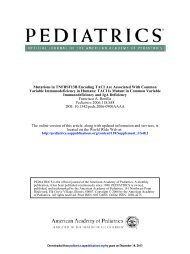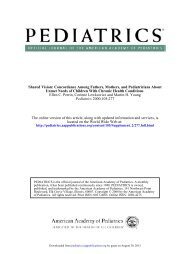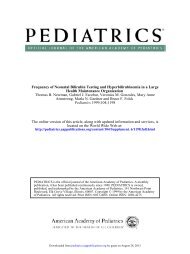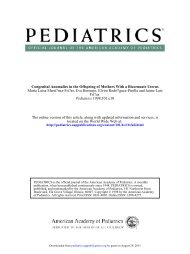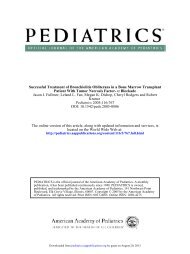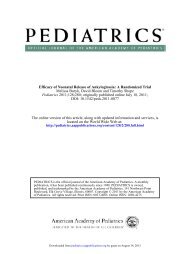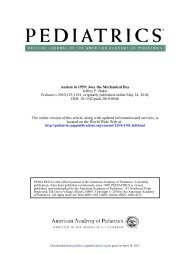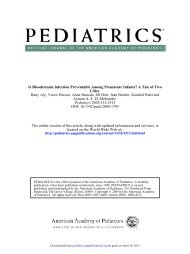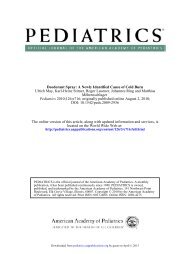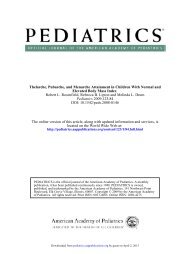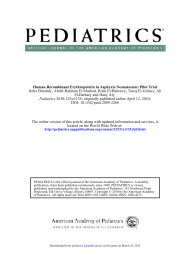Chewing Gum Bezoars of the Gastrointestinal Tract - Pediatrics
Chewing Gum Bezoars of the Gastrointestinal Tract - Pediatrics
Chewing Gum Bezoars of the Gastrointestinal Tract - Pediatrics
Create successful ePaper yourself
Turn your PDF publications into a flip-book with our unique Google optimized e-Paper software.
<strong>Chewing</strong> <strong>Gum</strong> <strong>Bezoars</strong> <strong>of</strong> <strong>the</strong> <strong>Gastrointestinal</strong> <strong>Tract</strong><br />
David E. Milov, Joel M. Andres, Nora A. Erhart and David J. Bailey<br />
<strong>Pediatrics</strong> 1998;102;e22<br />
The online version <strong>of</strong> this article, along with updated information and services, is<br />
located on <strong>the</strong> World Wide Web at:<br />
http://pediatrics.aappublications.org/content/102/2/e22.full.html<br />
PEDIATRICS is <strong>the</strong> <strong>of</strong>ficial journal <strong>of</strong> <strong>the</strong> American Academy <strong>of</strong> <strong>Pediatrics</strong>. A monthly<br />
publication, it has been published continuously since 1948. PEDIATRICS is owned,<br />
published, and trademarked by <strong>the</strong> American Academy <strong>of</strong> <strong>Pediatrics</strong>, 141 Northwest Point<br />
Boulevard, Elk Grove Village, Illinois, 60007. Copyright © 1998 by <strong>the</strong> American Academy<br />
<strong>of</strong> <strong>Pediatrics</strong>. All rights reserved. Print ISSN: 0031-4005. Online ISSN: 1098-4275.<br />
Downloaded from<br />
pediatrics.aappublications.org by guest on August 4, 2013
<strong>Chewing</strong> <strong>Gum</strong> <strong>Bezoars</strong> <strong>of</strong> <strong>the</strong> <strong>Gastrointestinal</strong> <strong>Tract</strong><br />
ABSTRACT. Children have chewed gum since <strong>the</strong> Stone<br />
Age. Black lumps <strong>of</strong> prehistoric tar with human tooth impressions<br />
have been found in Nor<strong>the</strong>rn Europe dating from<br />
7000 BC (Middle Stone Age) to 2000 BC (Bronze Age). 1<br />
The bite impressions suggest that most chewers were between<br />
6 and 15 years <strong>of</strong> age. The Greeks chewed resin from<br />
<strong>the</strong> mastic tree (mastic gum). North American Indians<br />
chewed spruce gum. The first manufacturing patent for<br />
chewing gum was issued in 1869 for a natural gum, chicle,<br />
derived from <strong>the</strong> Sopadilla tree, indigenous to Central<br />
America. <strong>Chewing</strong> gum sold today is a mixture <strong>of</strong> natural<br />
and syn<strong>the</strong>tic gums and resins, with added color and flavor<br />
sweetened with corn syrup and sugar. <strong>Chewing</strong> gum is big<br />
business. A significant amount <strong>of</strong> <strong>the</strong> $21 billion US candy<br />
industry sales is from chewing gums, many <strong>of</strong> which appeal<br />
almost exclusively to children. Despite <strong>the</strong> history and<br />
prevalence <strong>of</strong> gum chewing, <strong>the</strong> medical literature contains<br />
very little information about <strong>the</strong> adverse effects <strong>of</strong> chewing<br />
gum. In <strong>the</strong> present report, we briefly review gum-chewing<br />
complications and describe three children who developed<br />
intestinal tract and esophageal obstruction as a consequence<br />
<strong>of</strong> swallowing gum. <strong>Pediatrics</strong> 1998;102(2). URL:<br />
http://www.pediatrics.org/cgi/content/full/102/2/e22; gum,<br />
chewing gum, constipation; fecal mass.<br />
CASE REPORTS<br />
Case 1<br />
A boy, 41 ⁄2 years <strong>of</strong> age, was referred with a 2-year history <strong>of</strong><br />
constipation. His constipation was associated with encopresis and<br />
began shortly after toilet-training. Episodes consistent with fecal<br />
withholding were part <strong>of</strong> <strong>the</strong> interval history and included facial<br />
grimace, leg-stiffening, and buttock-clenching (“duty dance”). The<br />
early history was normal and included passage <strong>of</strong> meconium<br />
within <strong>the</strong> first 24 hours <strong>of</strong> life. The diet history was not unusual;<br />
he drank a total <strong>of</strong> 16 oz <strong>of</strong> cow milk daily. The family history<br />
included <strong>the</strong> patient’s fa<strong>the</strong>r with encopresis until 8 years <strong>of</strong> age,<br />
which resolved without treatment. A variety <strong>of</strong> laxative treatments<br />
and positive reinforcement was attempted. Candy, especially<br />
chewing gum, was given as a reward for successful toileting.<br />
Constipation was reported well before any candy or gum reward.<br />
The parent described <strong>the</strong> child’s stools as dry and “like glue.” The<br />
physical examination was normal except for soiled undergarment<br />
and a palpable firm mass in <strong>the</strong> left lower quadrant. The cremasteric<br />
and anal wink reflexes were present. Anorectal examination<br />
demonstrated normal sphincter tone without expulsion <strong>of</strong> gas or<br />
feces. A firm fecal mass was palpated at 3 cm from <strong>the</strong> anal<br />
verge. An unprepared barium enema study revealed a large<br />
amount <strong>of</strong> stool confined mostly to <strong>the</strong> rectum without a transition<br />
zone. The initial treatment plan was behavior modification with<br />
regular, daily intervals on <strong>the</strong> commode; mineral oil (30 mL bid);<br />
fiber supplements; and saline enemas (5 oz each night for 4<br />
nights). This clean-out regimen produced no results after 4 days.<br />
On <strong>the</strong> 5th day, <strong>the</strong> child was brought in for manual disimpaction<br />
under conscious sedation and rectal suction biopsy. On removal <strong>of</strong><br />
<strong>the</strong> leading edge <strong>of</strong> <strong>the</strong> fecoma, a “taffy-like” trail <strong>of</strong> fecal material<br />
remained in <strong>the</strong> rectum. This mass was eventually manually withdrawn<br />
and was primarily made up <strong>of</strong> chewing gum. On fur<strong>the</strong>r<br />
history, this boy always swallowed his gum after chewing five to<br />
Received for publication Dec 30, 1997; accepted Apr 9, 1998.<br />
Address correspondence to David E. Milov, MD, 83 West Columbia St,<br />
Orlando, FL 32806.<br />
PEDIATRICS (ISSN 0031 4005). Copyright © 1998 by <strong>the</strong> American Academy<br />
<strong>of</strong> <strong>Pediatrics</strong>.<br />
seven pieces <strong>of</strong> gum each day. The rectal biopsy demonstrated<br />
normal ganglion cells.<br />
Case 2<br />
A41 ⁄4-year-old girl was referred because <strong>of</strong> encopresis, constipation,<br />
and barium enema findings that showed megarectum. The<br />
early life, medical, and family histories were noncontributory. The<br />
physical examination revealed a palpable firm mass in <strong>the</strong> left<br />
lower quadrant, soiled undergarment, and firm stool in <strong>the</strong> rectal<br />
vault. Phosphosoda enema, fiber supplements, mineral oil, and<br />
behavior modification were ineffective. Manual disimpaction occurred<br />
7 days later with conscious sedation. On this occasion, <strong>the</strong><br />
fecal mass was unmistakably chewing gum, because it contained<br />
multiple spheres <strong>of</strong> chewed gum congealed into a multicolored<br />
rectal mass. Dislodging <strong>the</strong> mass revealed <strong>the</strong> taffy-pull sign.<br />
Ganglion cells were evident on rectal suction biopsy. After <strong>the</strong><br />
disimpaction, <strong>the</strong> family reported that chewing gum was part <strong>of</strong> a<br />
positive reinforcement system used on many occasions each day.<br />
The child had <strong>the</strong> habit <strong>of</strong> swallowing gum, <strong>of</strong>ten just to get<br />
ano<strong>the</strong>r piece.<br />
Case 3<br />
A11 ⁄2-year-old was brought to <strong>the</strong> emergency department with<br />
drooling, cough, and dysphagia <strong>of</strong> sudden onset. Chest x-ray<br />
examination revealed a radiopaque object, which appeared to be<br />
stacked coins, just below <strong>the</strong> cricopharyngeus. Upper endoscopy<br />
confirmed that <strong>the</strong> child had four coins in <strong>the</strong> proximal esophagus<br />
that were wrapped with a peculiar sticky wax-like substance (Fig<br />
1). When pulled on, <strong>the</strong> wax substance showed <strong>the</strong> taffy-pull sign<br />
on grasping by <strong>the</strong> coin retrieval instrument. The mass was advanced<br />
to <strong>the</strong> stomach; one coin was separated with difficulty and<br />
<strong>the</strong>n easily removed with a coin retriever. The remaining three<br />
adhered coins (2 dimes, 1 penny) <strong>the</strong>n were grasped in toto and<br />
withdrawn easily from <strong>the</strong> stomach. The parents reported that<br />
<strong>the</strong>ir child was chewing gum just before <strong>the</strong> onset <strong>of</strong> symptoms<br />
and was a regular user <strong>of</strong> gum despite her young age.<br />
DISCUSSION<br />
<strong>Chewing</strong> gum has been associated with many adverse<br />
health effects. In most cases, additives (sweeteners,<br />
flavorings, preservatives) and not gum induce<br />
pathology (Table 1). For example, sorbitol (in “sugarless”<br />
gum and candy) nonabsorption may cause<br />
diarrhea, abdominal pain, and flatulence. 2 Cinnamon<br />
flavoring has been linked to mouth ulcers. 3 Bubble<br />
gum may induce a perioral dermatitis with granulomatous<br />
histology; <strong>the</strong> postulated mechanism <strong>of</strong> this<br />
perifollicular lesion is selective absorption <strong>of</strong> certain<br />
gum oils by <strong>the</strong> follicle. 4 Chlorophylla, menthol, and<br />
butyl hydroxytoluene additives can induce a disseminated<br />
cutaneous urticaria. 5 Licorice flavoring in<br />
chewing gum (glycyrrhiza) can induce hypokalemia<br />
and hypertension. 6,7 Frequent oral cavity exposure to<br />
concentrated sugars facilitates dental caries.<br />
<strong>Gum</strong> chewing also may induce mechanical injury<br />
to teeth (Table 2), extrusion <strong>of</strong> dental repairs (fillings,<br />
crowns, bridges, orthodontics), and overuse injury<br />
including temporomandibular joint syndrome. A<br />
syndrome <strong>of</strong> temporalis and o<strong>the</strong>r masticatory muscle<br />
hypertrophy has been reported with so-called<br />
“chewing gum abuse.” 8 Mercury levels are higher in<br />
http://www.pediatrics.org/cgi/content/full/102/2/e22 PEDIATRICS Vol. 102 No. 2 August 1998 1<strong>of</strong>3<br />
Downloaded from<br />
pediatrics.aappublications.org by guest on August 4, 2013
Fig 1. Four coins stuck in gum lodged in esophagus.<br />
excessive gum chewers because <strong>of</strong> <strong>the</strong> release <strong>of</strong><br />
mercury from dental amalgam. 9<br />
In addition, <strong>the</strong> cost to maintain public and private<br />
facilities free <strong>of</strong> discarded chewing gum is enormous.<br />
<strong>Gum</strong> pollution (“gumfitti”) has created an entire industry<br />
<strong>of</strong> solvents and gum-removal devices. The<br />
environmental effects <strong>of</strong> using solvents to remove<br />
accidental or purposeful gum pollution has not been<br />
studied.<br />
Our report <strong>of</strong> two children with protracted constipation<br />
and chewing gum rectal bezoar is ano<strong>the</strong>r<br />
example <strong>of</strong> gum pollution requiring expensive clean<br />
up. O<strong>the</strong>r authors have previously reported gum<br />
removal to relieve symptoms. A patient was found to<br />
have a chewing gum obstruction <strong>of</strong> her endotracheal<br />
tube while undergoing elective surgery; she admitted<br />
her noncompliance to <strong>the</strong> NPO preoperative orders.<br />
10 Three separate case reports <strong>of</strong> bubble gum<br />
intestinal bezoar in children have been noted elsewhere.<br />
11–13 Swallowed bubble gum in <strong>the</strong> gastrointestinal<br />
tract simulated calcification on plain abdominal<br />
x-ray examination. 14<br />
Our report adds to an already long list <strong>of</strong> adverse<br />
health effects from chewing gum. Two patients,<br />
each toddlers, received gum on a daily basis<br />
and <strong>the</strong>ir means <strong>of</strong> discarding <strong>the</strong> gum (swallowing)<br />
was well known to <strong>the</strong> families and was a<br />
source <strong>of</strong> levity. Each child presented with intractable,<br />
medically refractory constipation that required<br />
manual stool removal. Interestingly, <strong>the</strong><br />
disimpaction procedure is characteristically a “taffy-pull.”<br />
The rainbow <strong>of</strong> fused, multicolored gum<br />
fragments in <strong>the</strong> removed fecoma is easily recognized<br />
by physician and family as old gum. It is<br />
assumed that <strong>the</strong> third patient, an infant, put multiple<br />
coins in her mouth at a time when she was<br />
chewing gum. The coin–gum mass produced<br />
esophageal obstruction when swallowed (Figure).<br />
The “taffy-pull” sign again was evident, and it was<br />
difficult to strip <strong>the</strong> gum away from <strong>the</strong> coins. The<br />
TABLE 1. Complications From Additives to <strong>Chewing</strong> <strong>Gum</strong><br />
Symptoms Cause<br />
Diarrhea, flatulence,<br />
borborygmi<br />
Sorbitol<br />
Mouth ulcers Cinnamon flavoring<br />
Perioral dermatitis <strong>Gum</strong> oils<br />
Diffuse cutaneous Chlorophylla, menthol,<br />
urticaria<br />
butylhydroxytoluene<br />
Dental caries Concentrated sweetener, corn<br />
syrup<br />
Hypertension,<br />
hypokalemia<br />
Licorice (glycyrrhetinic acid)<br />
TABLE 2. Adverse Mechanical Effects <strong>of</strong> <strong>Chewing</strong> <strong>Gum</strong><br />
Extrusion <strong>of</strong> dental work<br />
Temporomandibular joint syndrome<br />
Hypertrophy <strong>of</strong> masticatory muscle<br />
Increased serum mercury level<br />
Increased air swallowing<br />
Occlusion <strong>of</strong> endotracheal tube<br />
Esophageal or colonic bezoar<br />
finding <strong>of</strong> an imperfectly round coin on x-ray examination<br />
has been reported to indicate <strong>the</strong> presence<br />
<strong>of</strong> multiple adhered coins.<br />
In summary, chewing gum should not be swallowed<br />
and not given to children who cannot understand<br />
this point. <strong>Chewing</strong> gum does have occasional<br />
beneficial use as a delivery system for drugs (nicotine,<br />
aspirin, bismuth). However, chewing gum has<br />
documented deleterious effects in <strong>the</strong> oral cavity and<br />
may obstruct <strong>the</strong> esophagus and colon. With regard<br />
to <strong>the</strong> older infant and toddler, anticipatory guidance<br />
about gum should be outlined for <strong>the</strong> parent. For<br />
example, <strong>the</strong> toddler with constipation should also<br />
have practice <strong>of</strong> gum-chewing noted in <strong>the</strong> medical<br />
history. <strong>Gum</strong>-swallowing in a child with chronic<br />
constipation or acute coughing and drooling should<br />
raise suspicion about chewing gum intestinal or<br />
esophageal bezoar. This is especially important<br />
when <strong>the</strong> taffy-pull sign accompanies <strong>the</strong> manual<br />
disimpaction or even is noted on routine rectal examination.<br />
David E. Milov, MD<br />
Joel M. Andres, MD<br />
Nora A. Erhart, MD<br />
David J. Bailey, MD<br />
Nemours Children’s Clinic<br />
Division <strong>of</strong> Gastroenterology and Nutrition<br />
Orlando, FL 32806<br />
REFERENCES<br />
1. Aveling E. Chew, chew that ancient chewing gum. Br Archaeol. 1997;21:<br />
1–2<br />
2. Hyams JS. Sorbitol intolerance: an unappreciated cause <strong>of</strong> functional<br />
abdominal complaints. Gastroenterology. 1983;84:80–83<br />
3. Allen CM, Bloziss G. Oral mucosal reactions to cinnamon-flavored<br />
chewing gum. J Am Dent Assoc. 1988;116:664–667<br />
4. Georgouras K, Kocsard E. Maculopapular sarcoidal facial eruption in a<br />
child: Gianotti-type perioral dermatitis. Acta Dermato-Vencreologica.<br />
1978;58:433–436<br />
5. Moneret-Vautrin DA, Faure G, Bene MC. <strong>Chewing</strong> gum preservative<br />
induced toxidermic vasculitis. Allergy. 1986;41:546–548<br />
6. Rosseel M, Schoors D. <strong>Chewing</strong> gum and hypokalemia. Lancet. 1993;<br />
341:175. Letter<br />
2<strong>of</strong>3 CHEWING GUM BEZOARS OF THE GASTROINTESTINAL TRACT<br />
Downloaded from<br />
pediatrics.aappublications.org by guest on August 4, 2013
7. DeKlerk GJ, Nicuwenhuis MG, Beutler JJ. Hypokalemia and hypertension<br />
associated with <strong>the</strong> use <strong>of</strong> liquor flavored chewing gum. Br Med J.<br />
1997;314:731–732<br />
8. Kradel B, Hackett A, Johnstone R. NPO includes chewing gum. Anes<strong>the</strong>sia<br />
Analgesia. 1992;74:621. Letter<br />
9. Sallsten G, Thoren J, Barregaard L, Schutz A, Skarping G. Long-term use<br />
<strong>of</strong> nicotine chewing gum and mercury exposure from dental amalgam<br />
fillings. J Dent Res. 1996;75:594–598<br />
10. Bevaqua BK, Cleary WF. An unusual case <strong>of</strong> endotracheal tube cuff<br />
dysfunction. J Clin Anesth. 1993;5:237–239<br />
11. Boltshauser E. Hypertrophy <strong>of</strong> temporalis muscle due to chewing gum<br />
“abuse.” J Child Neurol. 1996;11:210<br />
12. Truex JH, Silberman TL, Wood BP. Bubble gum bezoar. Am J Disease<br />
Child. 1989;143:253–254<br />
13. Cotner M. Fecal impaction due to bubble gum bezoar. South Med J..<br />
1992;75:775<br />
14. Geller E, Smergel EM. Bubble gum simulating abdominal calcifications.<br />
Pediatr Radiol. 1992;22:298–299<br />
http://www.pediatrics.org/cgi/content/full/102/2/e22 3<strong>of</strong>3<br />
Downloaded from<br />
pediatrics.aappublications.org by guest on August 4, 2013
<strong>Chewing</strong> <strong>Gum</strong> <strong>Bezoars</strong> <strong>of</strong> <strong>the</strong> <strong>Gastrointestinal</strong> <strong>Tract</strong><br />
David E. Milov, Joel M. Andres, Nora A. Erhart and David J. Bailey<br />
<strong>Pediatrics</strong> 1998;102;e22<br />
Updated Information &<br />
Services<br />
References<br />
Subspecialty Collections<br />
Permissions & Licensing<br />
Reprints<br />
including high resolution figures, can be found at:<br />
http://pediatrics.aappublications.org/content/102/2/e22.full.ht<br />
ml<br />
This article cites 14 articles, 5 <strong>of</strong> which can be accessed free<br />
at:<br />
http://pediatrics.aappublications.org/content/102/2/e22.full.ht<br />
ml#ref-list-1<br />
This article, along with o<strong>the</strong>rs on similar topics, appears in <strong>the</strong><br />
following collection(s):<br />
Teaching/Curriculum Development<br />
http://pediatrics.aappublications.org/cgi/collection/teaching_c<br />
urriculum_dev_sub<br />
Dentistry/Oral Health<br />
http://pediatrics.aappublications.org/cgi/collection/dentistry:or<br />
al_health_sub<br />
Gastroenterology<br />
http://pediatrics.aappublications.org/cgi/collection/gastroenter<br />
ology_sub<br />
Information about reproducing this article in parts (figures,<br />
tables) or in its entirety can be found online at:<br />
http://pediatrics.aappublications.org/site/misc/Permissions.xht<br />
ml<br />
Information about ordering reprints can be found online:<br />
http://pediatrics.aappublications.org/site/misc/reprints.xhtml<br />
PEDIATRICS is <strong>the</strong> <strong>of</strong>ficial journal <strong>of</strong> <strong>the</strong> American Academy <strong>of</strong> <strong>Pediatrics</strong>. A monthly<br />
publication, it has been published continuously since 1948. PEDIATRICS is owned, published, and<br />
trademarked by <strong>the</strong> American Academy <strong>of</strong> <strong>Pediatrics</strong>, 141 Northwest Point Boulevard, Elk Grove<br />
Village, Illinois, 60007. Copyright © 1998 by <strong>the</strong> American Academy <strong>of</strong> <strong>Pediatrics</strong>. All rights<br />
reserved. Print ISSN: 0031-4005. Online ISSN: 1098-4275.<br />
Downloaded from<br />
pediatrics.aappublications.org by guest on August 4, 2013



